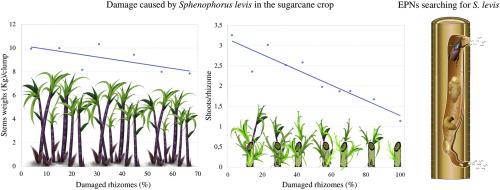当前位置:
X-MOL 学术
›
Crop Prot.
›
论文详情
Our official English website, www.x-mol.net, welcomes your feedback! (Note: you will need to create a separate account there.)
Behavioral aspects of Sphenophorus levis (Coleoptera: Curculionidae), damage to sugarcane and its natural infection by Steinernema carpocapsae (Nematoda: Rhabditidae)
Crop Protection ( IF 2.8 ) Pub Date : 2020-11-01 , DOI: 10.1016/j.cropro.2020.105262 Alexsandro Casteliani , Lizandra de Fatima Martins , Jorge Franco Maringoli Cardoso , Mateus Salviano Oliveira Silva , Raphael Satochi Abe da Silva , Julie Giovanna Chacon-Orozco , Ana Gabriele Barbosa Casteliani , Vladimír Půža , Ricardo Harakava , Luis Garrigos Leite
Crop Protection ( IF 2.8 ) Pub Date : 2020-11-01 , DOI: 10.1016/j.cropro.2020.105262 Alexsandro Casteliani , Lizandra de Fatima Martins , Jorge Franco Maringoli Cardoso , Mateus Salviano Oliveira Silva , Raphael Satochi Abe da Silva , Julie Giovanna Chacon-Orozco , Ana Gabriele Barbosa Casteliani , Vladimír Půža , Ricardo Harakava , Luis Garrigos Leite

|
Abstract In Brazil, the sugarcane billbug Sphenophorus levis (Coleoptera: Curculionidae) bores sugarcane rhizomes in its larval stage, causing high losses to the crop. Entomopathogenic nematodes (EPNs) of the genera Heterorhabditis and Steinernema (Nematoda: Rhabditidae) could be applied in the sugarcane fields to control the larvae and pupae of S. levis inside rhizomes. However, it is not clear whether this insect leaves an opening in the rhizome that would allow EPNs to enter and reach the insects in their immature stages. In addition, there is still no record of the natural occurrence of EPNs in the immature stages of S. levis or on the losses this insect can cause to sugarcane crops. This work aimed to investigate aspects of S. levis behavior on sugarcane plants and to determine the cane damage and crop loss percentage it causes through observations and regular evaluations of plants in the field; as well as to assess the natural occurrence of EPNs in the insect population found inside the cane rhizomes. For every 1% increase in its damage to the rhizomes, S. levis caused a 1% loss in the cane crop due to reductions of 0.318% in the weight of the stems and of 0.68% in the number of shoots generated by the rhizomes. The insect leaves openings that link the tunnels inside the root to the outside; these openings are made by adults during oviposition or by last-instar larva to allow the adults to exit. Almost 90% of the openings were made below the ground, allowing EPNs to enter the tunnels to reach the insect life stages inside the root. Steinernema carpocapsae was found to cause natural infection in S. levis inside the root, providing up to 60% pupal mortality. This information may help to establish the level of economic damage caused by S. levis and highlights EPNs as a potential alternative for S. levis control; their application just after cane harvesting is suggested in order to reduce the S. levis population in the next plant generation.
中文翻译:

Sphenophorus levis (鞘翅目: Curculionidae) 的行为方面, 对甘蔗的损害及其由 Steinernema carpocapsae (Nematoda: Rhabditidae) 的自然感染
摘要 在巴西,甘蔗臭虫 Sphenophorus levis (Coleoptera: Curculionidae) 在幼虫阶段钻入甘蔗根茎,对作物造成巨大损失。Heterorhabditis 和 Steinernema (Nematoda: Rhabditidae) 的昆虫病原线虫 (EPNs) 可用于甘蔗田控制根状茎内的 S. levis 幼虫和蛹。然而,尚不清楚这种昆虫是否在根茎中留下一个开口,允许 EPNs 进入并到达未成熟阶段的昆虫。此外,在 S. levis 的未成熟阶段或这种昆虫可能对甘蔗作物造成的损失方面,仍然没有 EPNs 自然发生的记录。这项工作旨在调查 S. levis 对甘蔗植物的行为,并通过对田间植物的观察和定期评估来确定其造成的甘蔗损害和作物损失百分比;以及评估在甘蔗根茎内发现的昆虫种群中 EPN 的自然发生。由于茎的重量减少 0.318%,根茎产生的枝条数量减少 0.68%,S. levis 对根茎的损害每增加 1%,甘蔗作物就会减少 1%。昆虫留下将根部内部的隧道连接到外部的开口;这些开口由成虫在产卵期间或由末龄幼虫打开,以允许成虫离开。几乎 90% 的开口都在地下,允许 EPN 进入隧道到达根部内的昆虫生命阶段。Steinernema carpocapsae 被发现在根内引起 S. levis 的自然感染,提供高达 60% 的蛹死亡率。此信息可能有助于确定李维斯造成的经济损失水平,并强调 EPN 作为控制李维斯的潜在替代方案;建议在甘蔗收获后立即使用它们,以减少下一代植物中的李氏链球菌种群。
更新日期:2020-11-01
中文翻译:

Sphenophorus levis (鞘翅目: Curculionidae) 的行为方面, 对甘蔗的损害及其由 Steinernema carpocapsae (Nematoda: Rhabditidae) 的自然感染
摘要 在巴西,甘蔗臭虫 Sphenophorus levis (Coleoptera: Curculionidae) 在幼虫阶段钻入甘蔗根茎,对作物造成巨大损失。Heterorhabditis 和 Steinernema (Nematoda: Rhabditidae) 的昆虫病原线虫 (EPNs) 可用于甘蔗田控制根状茎内的 S. levis 幼虫和蛹。然而,尚不清楚这种昆虫是否在根茎中留下一个开口,允许 EPNs 进入并到达未成熟阶段的昆虫。此外,在 S. levis 的未成熟阶段或这种昆虫可能对甘蔗作物造成的损失方面,仍然没有 EPNs 自然发生的记录。这项工作旨在调查 S. levis 对甘蔗植物的行为,并通过对田间植物的观察和定期评估来确定其造成的甘蔗损害和作物损失百分比;以及评估在甘蔗根茎内发现的昆虫种群中 EPN 的自然发生。由于茎的重量减少 0.318%,根茎产生的枝条数量减少 0.68%,S. levis 对根茎的损害每增加 1%,甘蔗作物就会减少 1%。昆虫留下将根部内部的隧道连接到外部的开口;这些开口由成虫在产卵期间或由末龄幼虫打开,以允许成虫离开。几乎 90% 的开口都在地下,允许 EPN 进入隧道到达根部内的昆虫生命阶段。Steinernema carpocapsae 被发现在根内引起 S. levis 的自然感染,提供高达 60% 的蛹死亡率。此信息可能有助于确定李维斯造成的经济损失水平,并强调 EPN 作为控制李维斯的潜在替代方案;建议在甘蔗收获后立即使用它们,以减少下一代植物中的李氏链球菌种群。



























 京公网安备 11010802027423号
京公网安备 11010802027423号